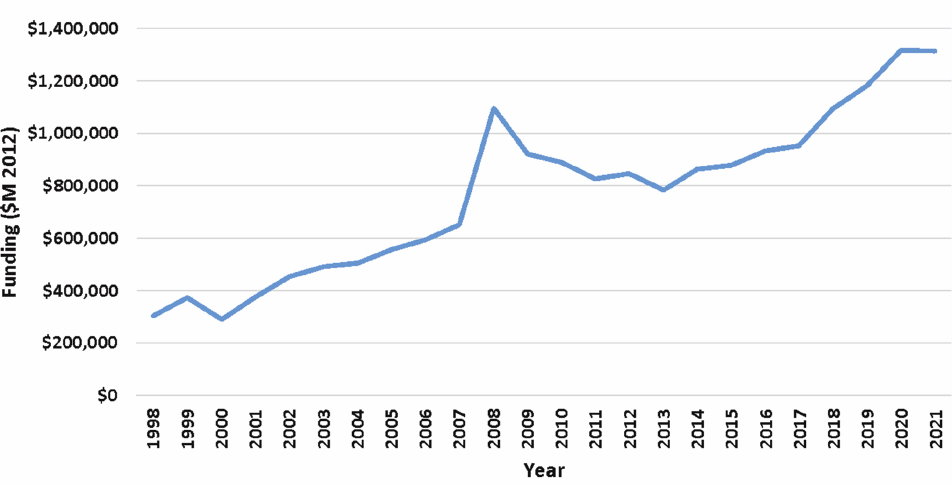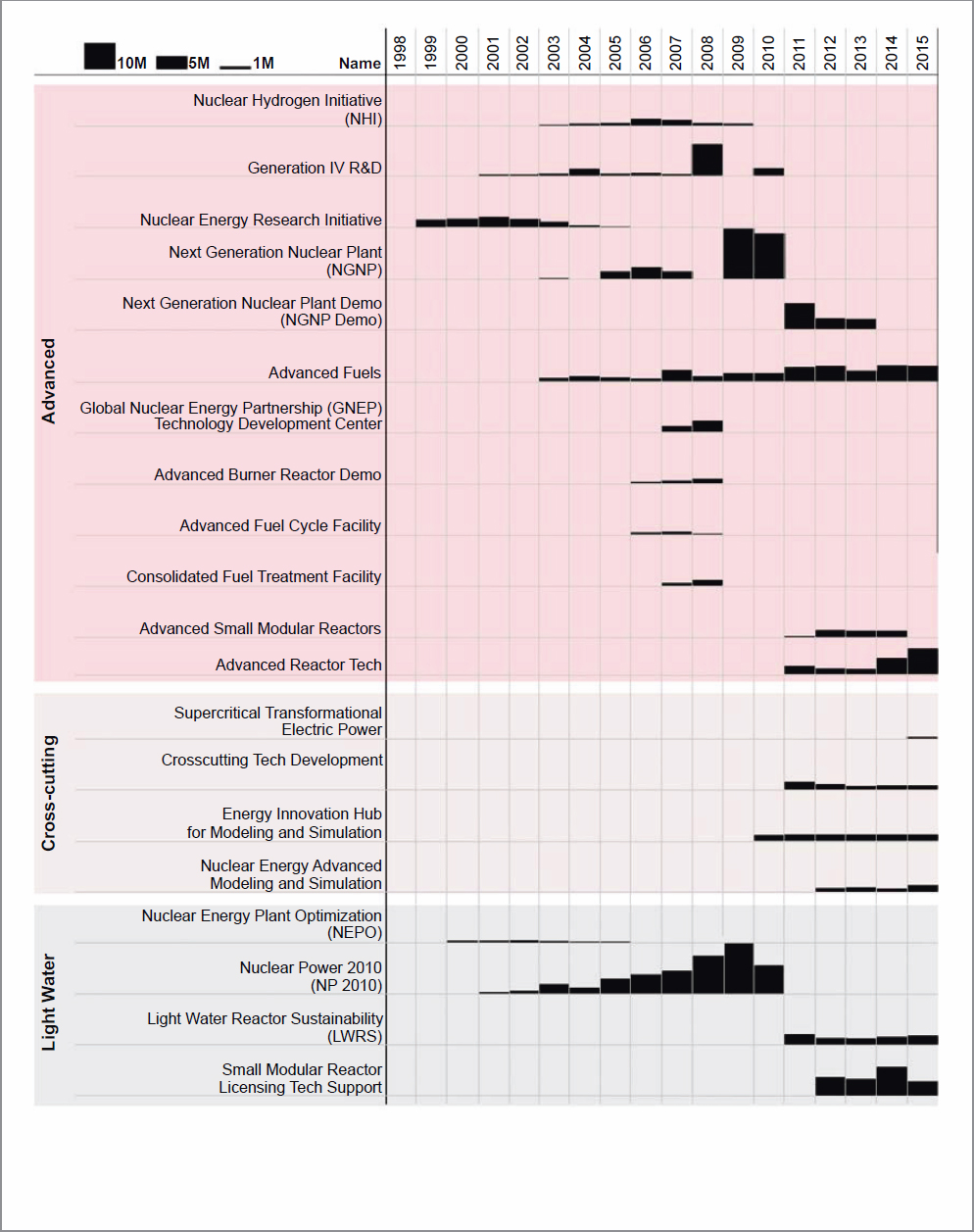C
Summary of Historical and Lessons-Learned Factors from the Department of Energy Office of Nuclear Energy–Funded Research and Development Programs in Support of Advanced Nuclear
The Department of Energy Office of Nuclear Energy (DOE NE) reactor technology research and development (R&D) portfolio has grown dramatically in scale since 1998, the year it reached its nadir. In 1998, there was essentially no funding for reactor technology R&D apart from ~$12 million ($ 2012) for university research program support of research and training reactors on university campuses. The only significant activity was continued work to decommission the Experimental Breeder Reactor (EBR-II) and sustain the nuclear infrastructure at Idaho National Laboratory (DOE 2021). The funding landscape has changed dramatically since this low point, with fiscal year 2021 funding reaching >$1.3 billion (real $ 2012), ~$800 million of which is focused on development of new fuels, waste management, advanced reactor development and sustaining the existing fleet of light water reactors (Figure C-1).
Despite this >400 percent funding growth, there have been few successes to point to in the demonstration of new nuclear generation technologies in the past 20+ years. A recent study indicated that for DOE NE funded programs since 1998,
Numerically, more than half have been dedicated to advanced nuclear initiatives: on average, these have lasted less than 5 years and cost less than $160 million each. Using DOE’s own roadmaps as a guide, these are of neither the duration nor the funding level necessary to develop a non-light water reactor. (Abdulla et al. 2017)
Construction and deployment of radioisotope production facilities such as SHINE, funded through the National Nuclear Security Administration (NNSA) and the recent development of the NASA funded Kilopower Reactor using Stirling Technology (KRUSTY) for space applications indicate that technical challenges in the nuclear domain can be met and new technologies can be demonstrated. But larger development efforts supported (and often managed) by DOE NE that may allow nuclear to play a larger role in decarbonization have not led to the deployment of a new reactor design concept in the United States, with frequent program starts and stops as administrations change and research focus waxes and wanes (Ford et al. 2017). Figure C-2 provides an indication of the program breakdown for the past 23 years.
An analysis of all programs does point to at least partial success in two projects. The first was the development of accident tolerant fuels, an effort that has come at significant cost, with over $1 billion invested in advanced fuels since 2003. The crown jewel of this effort is TRISO fuel, which has become a dominant fuel form in many advanced reactor designs. It remains to be seen if this fuel will prove affordable and sustainable in the long term,

because none of the designs that anticipate use of this fuel have yet been demonstrated and a reliable commercial supply of High Assay Low Enriched Uranium (HALEU) needed to develop a sustainable TRISO fuel cycle faces regulatory and policy challenges. It does promise to have safety advantages and may allow for longer time span for fuel usage in a reactor before refueling.
The other was the Nuclear Power 2010 Program (NP 2010), which began in 2001 and succeeded in supporting two light water reactor designs through the development, licensing, and siting process—that is, Westinghouse AP1000 and the GE-Hitachi Economic Simplified Boiling Water Reactor (ESBWR). The program had four goals (Longnecker and Associates 2012):
- Evaluate the business case for building new nuclear power plants.
- Identify sites for new nuclear power plants.
- Demonstrate untested regulatory processes (Combined Operating License process).
- Develop advanced nuclear plant technologies.
The program received a total of >$725 million, and ultimately helped improve readiness for deployment of these Generation III+ designs. Reflecting success in meeting at least two of the goals of this DOE support effort (1 and 2), nuclear vendors and utilities saw viability in deploying the next generation of LWR designs and construction began in 2008 on two Westinghouse AP1000 plants at Summer, South Carolina, following the new combined operating license (COL) process. This was followed in 2013 by construction start at the Vogtle site in Georgia. The plants were able to obtain COLs, reflecting the successful exercise of the regulatory process (3), albeit at great expense. Given that the Summer plant project ultimately was cancelled and the Vogtle plants are far behind schedule and over budget, it is highly unlikely that these designs will be exploited in further new construction in the United States.1 Thus, the implicit objective of the program, demonstrating a pathway for new construction, was not a success owing to project management issues, which are discussed in greater detail in Chapter 6.
___________________
1 Note: Four AP1000 plants were constructed in China, at Sanmen site in Zhejiang, and Haiyang site in Shandong.

The NP 2010 effort did show that DOE can support development and deployment of nuclear technologies through to actual construction. This is, however, not the case with another technology development effort which began not long after initiation of the NP 2010 effort—the Next Generation Nuclear Plant (NGNP) Program. The NGNP Program aimed to develop a high temperature gas reactor to generate both electricity and high temperature process heat for industrial applications, with construction of the first unit to begin in 2017. After eight years and $640 million in funding, DOE NE cancelled further development efforts owing to an inability to successfully partner with industry in the deployment phase of the project for a specific reactor design. A 2014 report from the Government Accountability Office summarized the project as follows:
Among the advanced reactor technologies that NE’s R&D currently supports, the high-temperature gas-cooled reactor is the technology that is most likely to be deployed and commercialized in the near term, according to an NE planning document. NE officials said this likelihood is based on the wide range of potential industry market applications and because of substantial government investments in the technology’s development. NE has been pursuing this technology under the Next Generation Nuclear Plant (NGNP) Project, as established by the Energy Policy Act of 2005 (EPAct 2005). Under EPAct 2005, DOE is to deploy a prototype reactor for NGNP by the end of fiscal year 2021. However, in 2011, DOE decided not to proceed with the deployment phase of this project, citing several barriers. For example, NE and industry have been unable to reach an agreement on a cost-share arrangement to fund the deployment phase because of a disagreement on the applicable cost-share levels and how and when the cost-share would be applied to specific activities or project phases. Although NE continues to conduct R&D for the NGNP Project, it has not developed a strategy to overcome the cost-share issue and other barriers to resuming the deployment phase of the project. (GAO 2014)
Understanding the differences in the structures of these two programs may be critical in evaluating performance risk in the current advanced reactor development program. The structure of the NGNP Program was spelled out in March 2008 with issuance of the Preliminary Project Management Plan (INL 2008). The status of the program was updated in a 2010 report to Congress and was again detailed in a 2011 INL report that summarized the challenges the program faced and the rationale for effectively cancelling the program prior to the demonstration phase (GAO 2014; Demick 2011).
NP 2010, which ultimately led to the commercial development of a new reactor design (AP1000), was apparently better supported by industry, more likely to lead to deployment,2 and focused on risk reduction in modular design, and employment of the 10CFR Part 52 regulatory process. Nevertheless, the root causes of the Summer project cancellation and Vogtle schedule delays and cost overruns also requires an assessment of these programs. This would be beneficial, emphasizing a review of programs differences tied to program duration, vendor/industry support, design risk, control of intellectual property, and cost share parameters. NP 2010 ended prior to full execution of the Summer and Vogtle builds. Perhaps an extension of government support, to include construction and initial commercial deployment, may be considered for the Advanced Reactor Demonstration Program (ARDP). Understanding these issues and factoring them into program design may be crucial in ensuring the success of the ARDP.
REFERENCES
Abdulla, A., M. Ford, M.G. Morgan, and D.G. Victor. 2017 “A Retrospective Analysis of Funding and Focus in US Advanced Fission Innovation.” Environmental Research Letters. https://doi.org/10.1088/1748-9326/aa7f10.
Demick, L.E. 2011. NGNP Project 2011 Status and Path Forward. Idaho Falls, ID: Idaho National Laboratory. INL/EXT-11-23907. https://doi.org/10.2172/1035900.
DOE (Department of Energy). 2021. “Budget (Justification & Supporting Documents).” https://www.energy.gov/cfo/listings/budget-justification-supporting-documents.
Ford, M.J., A. Abdulla, M.G. Morgan, and D.G. Victor. 2017. “Expert Assessments of the State of U.S. Advanced Fission Innovation.” Energy Policy 108(September):194–200. https://doi.org/10.1016/j.enpol.2017.05.059.
GAO (Government Accountability Office) 2014. “Advanced Reactor Research: DOE Supports Multiple Technologies But Actions Needed to Ensure a Prototype Is Built.” https://www.gao.gov/assets/gao-14-545.pdf.
INL (Idaho National Laboratory). 2008. Next Generation Nuclear Plant Project Preliminary Project Management Plan. PLN-2489. INL/EXT-05-00952. Idaho Falls, ID.
Longnecker and Associates. 2012. Nuclear Power 2010 Program: Combined Construction and Operating License & Design Certification Demonstration Projects Lessons Learned Report. Washington, DC: Department of Energy.
___________________
2 Transactions of the American Nuclear Society 117(October 2017):225–228, Washington, DC.




